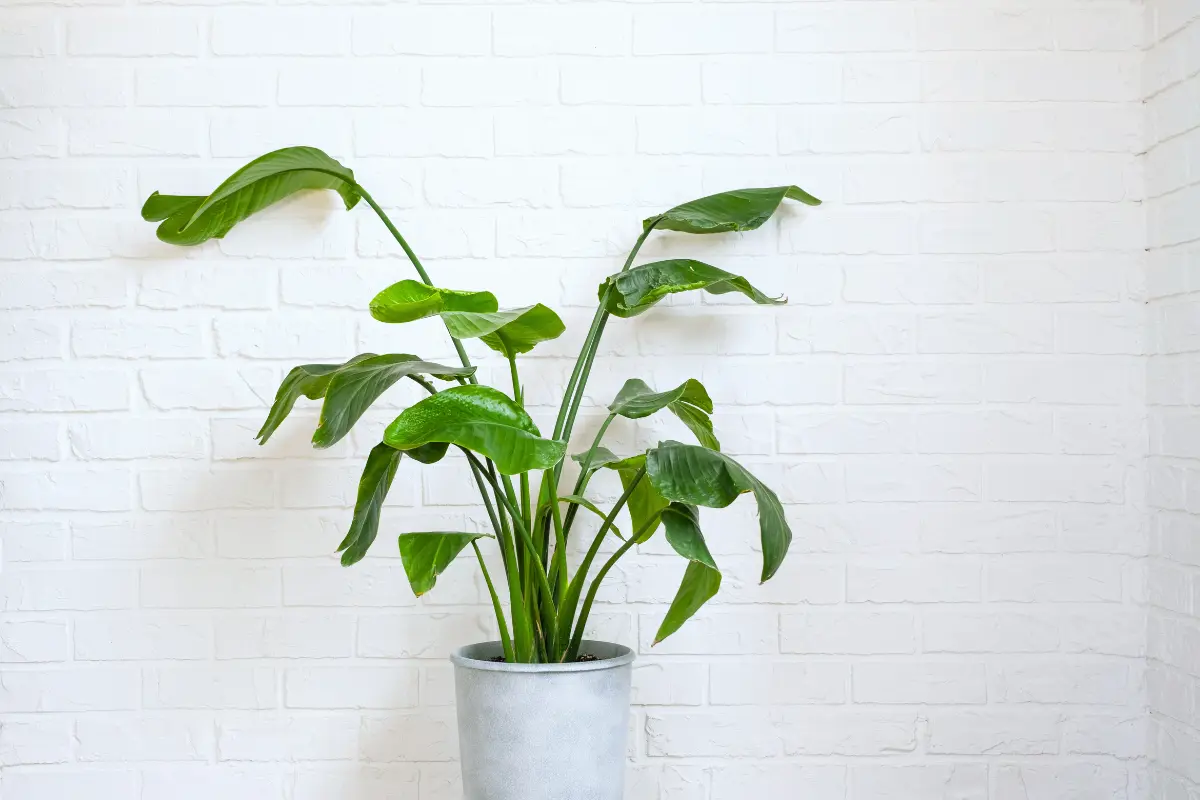White Bird of Paradise Plant: Grow, Care and Buying Guide
Introducing the White Bird of Paradise, a magnificent and truly royal plant which Native to the subtropical regions of South Africa, this tropical marvel, known by its scientific name Strelitzia Nicolai, was named in honor of Her Highness Queen Charlotte of Mecklenburg-Strelitz of England, a well-known lover of botany and the arts. Its glossy, broad, and long leaves create a sculptural silhouette, towering to great heights and playfully hanging like birds in flight. These paddle-shaped leaves grow in a fan-like formation, resembling feathers, making the plant a breathtaking focal point in any room or garden.
With its stunning foliage, impressive size, and striking presence, the White Bird of Paradise effortlessly gives a tropical touch to your indoor spaces. Its green colour, distinct ribbing, and bold form make it a natural statement and centrepiece. Ideal for both home and garden, this plant continues to grace interiors with elegance, living up to its status as a magnificent, royal plant.
|
Feature |
Details |
|---|---|
|
Common Name |
White Bird of Paradise |
|
Scientific Name |
Strelitzia nicolai |
|
Plant Type |
Tropical evergreen; ornamental foliage plant |
|
Mature Size |
5–10 ft indoors, up to 20–30 ft outdoors |
|
Light |
Bright, indirect light; can handle full sun |
|
Water |
Moderate; water when top inch of soil is dry |
|
Soil Type |
Well-draining, fertile loamy soil |
|
Bloom Time |
Late winter to early spring (if mature and outdoors) |
|
Flower Color |
White with bluish or grayish centers |
|
Hardiness Zones |
USDA Zones 9–11 |
|
Native Region |
South Africa |
|
Growth Rate |
Moderate to fast (in optimal light and temperature) |
|
Toxicity |
Mildly toxic to pets (cats and dogs) if ingested |
|
Fertilizer Needs |
Feed monthly in spring and summer with balanced fertilizer |
|
Ideal Temperature |
65–85°F (18–29°C); protect from frost |
|
Humidity Preference |
Medium to high; mist leaves occasionally indoors |
|
Common Issues |
Leaf browning, curling, or splits due to low humidity, pests, or underwatering |
|
Container Friendly |
Yes – grows well in large indoor pots with proper drainage |
How to Grow and Care for Strelitzia Nicolai
Watering
When it comes to watering your White Bird of Paradise, I’ve found that paying close attention to the top inch of the soil is key. Only water when it feels dry, especially the first 1 inch of topsoil, to prevent the risk of root rot. Always make sure to thoroughly soak the root ball, then let the excess water drain completely—this is important because Strelitzia nicolai doesn’t like standing water. During the colder months of winter, it’s best to cut back on the frequency of watering and let the plant rest.
Light Requirments
The White Bird of Paradise thrives best when it receives bright but not harsh direct light, with sunlight that streams inside your home, ideally near south-facing windows where the plant gets the most proper light. It can also adapt well to indirect light, where sun rays are diffused or filtered sunlight, which helps it tolerate lower light conditions.
However, you should avoid placing it in low light or spots without natural sunlight. In a harsh climate with high temperatures, always monitor the placement because intense direct light may cause the leaves to scorch, show dark spots, or curl. Finding the right balance between light and shade is crucial to keeping your Strelitzia nicolai healthy and vibrant.
Soil and Repotting
For White Bird of Paradise, a well-draining potting mix is key—think tropical plants love airy, nutrient-rich soil. A mixture of peat moss, perlite, and a bit of sand or vermiculite works wonders for growth and flowering. When it’s time to repot (every 2–3 years or when the plant outgrows its container), opt for a slightly larger version to avoid stressful moving. Gently loosen the root ball, cover with fresh mix, and ensure drainage holes prevent roots from sitting in water. Over time, avoid over-fertilizing—this process keeps your White Bird of Paradise thriving without shocking its system.
Temperature and Humidity
White Bird of Paradise thrives in warm temperatures between 60˚F and 80˚F (16˚C to 27˚C). While it can tolerate temperatures as low as 32˚F, you should avoid exposing it to anything below 29˚F—cold drafts from AC vents, heaters, or radiators can harm it. At night, when the sun goes down, a slight drop to 50˚F–55˚F (10˚C–13˚C) is fine. Just place it away from cold sources to prevent stress.
This plant loves high humidity, and if you notice crispy, brown edges, it’s likely begging for more moisture. To create a humid environment, try regular misting, a tray of water nearby, or a humidifier. While it handles average indoor humidity levels, it appreciates slightly higher humidity—think steamy bathroom or kitchen. A little effort here ensures a favourable microclimate, keeping your plant lush and happy.
Fertilizing
When caring for your Strelitzia nicolai, using a balanced, water-soluble fertiliser specifically formulated for tropical plants works wonders during the growing season (spring and summer). Apply it according to the manufacturer’s instructions. Typically dilute it slightly more than recommended to be safe. The golden rule? Avoid over-fertilising at all costs. Remember, it’s better to feed too little than too much – your plant will thank you for showing restraint while still getting the nutrients it needs to thrive.
How to propagate your giant bird of paradise
Division Propagation
For quicker results, try division – what I call plant surgery. Unpot your grown plant and gently tease apart the root ball, using a sterilized knife if needed. Each new unit should have healthy roots and leaves. After potting, water well and keep in indirect light. It’s my favorite hack for instant new plants.
Propagation from Seed
Starting with seeds from a mature White Bird of Paradise flower requires patience but feels rewarding. After letting them dry, soak them for a day to soften that tough outer coat. Sow in well-draining soil and wait out the germination game – it might take weeks or even months, but the payoff is worth it.
Stem Cutting Method:
Stem cuttings offer the simplest cut-and-paste approach. Snip a healthy stem, dip the cut end in rooting hormone, and plant in moist soil. Maintain humidity by keeping the air slightly damp (but never soggy). This waiting game tests your patience, but soon you’ll have a brand-new plant to cherish.
Rhizomes Division
Don’t overlook those underground stems called rhizomes. Unearth these horizontal wonders and slice into sections, each with a growth point. Replant these chunks and watch the magic happen. It’s cloning without the sci-fi fuss – nature’s way of giving you free plants.
Toxicity Concern
The toxicity of this giant houseplant is a real concern, especially for children, cats, and dogs. While the leaves and stems are only mildly toxic in large amounts, the flowers and seeds can cause more severe effects like dizziness, drowsiness, diarrhea, and vomiting if ingested. The chemical tannins give it a bitter taste, which helps deter pets from chewing too much, but it’s best to keep this plant out of reach for safety. If any part is eaten, contact a veterinarian immediately, as the intensity of the reaction depends on the amount ingested.
White Bird of Paradise Problems You Can Fix Fast
Light-Related Issues and Solutions
The White Bird of Paradise thrives in bright but indirect light. If you notice wilting or curling leaves, your plant likely needs more sunlight. Move it to a brightly lit area. However, direct sunlight can cause scorching and brown spots – if this occurs, diffuse the light or relocate the plant to a spot with filtered light.
Water and Humidity Problems
Brown, crispy edges on leaves indicate low humidity – increase moisture levels using a humidifier. Leaf burn might mean there’s too much salt in your water. Use filtered water and maintain consistent watering. Keep the temperature moderate, as hot conditions can stress the plant.
Pest Prevention and Leaf Care
While generally prone to few pests, occasionally insects may appear. Regularly wipe the leaves with a damp, soft cloth to keep them clean and pest-free. This also helps monitor the condition of your plant.
Environmental Adjustments
From experience, small changes make big differences. Ensure proper space for growth, the right size pot, and a suitable home environment. Avoid placing near heat sources or drafty windows. With proper care, your White Bird of Paradise will flourish with healthy leaves.

